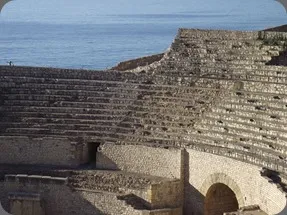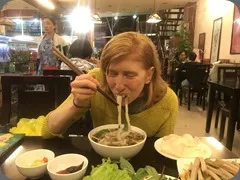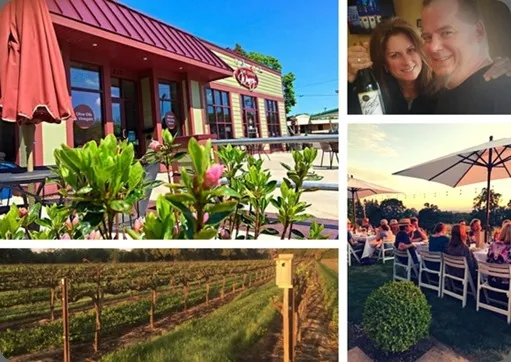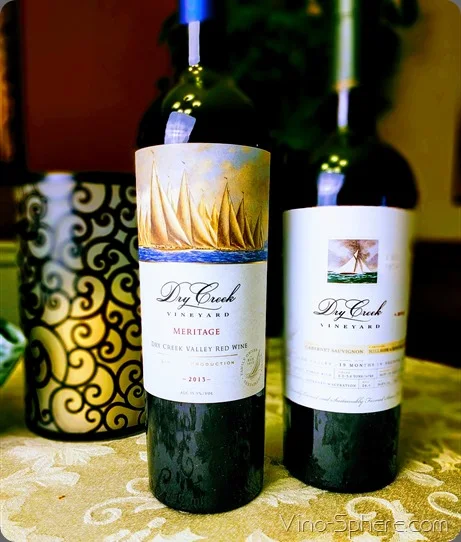Sweet, sour, salty and spicy – Southeast Asian cuisine can be all that in one bite. So when we hosted a vegan dinner with dishes from that region, the challenge was on to find just the right wines.
Asian Adventure On A Hot Plate
Hiking through the rainforests of Southeast Asia, driving a motorbike on the jungle roads of Vietnam, splashing in the waters of a pristine beach. It all sounds idyllic. Of course it does – unless you are the somewhat nervous parent of the young lady doing it all!
Our daughter Rachel returned jet-lagged, but safe and sound from her recent trip halfway around the globe. She not only had loads of stories and photos from her trip with her boyfriend Jason, but returned with a taste for the savory flavors of the region.
Rachel is a vegan baker and chef with baking and cooking experience around the US, especially in locations with ski boarding slopes. Now she’s launching her own enterprise called
Earth N Oven. Following her return from abroad, she presented an evening of food, wine and conversation for our party of eight.
What Wine Goes With Fermented Soybeans?
Any chump can find the proper wine to pair with juicy steak (bold Cabernet Sauvignon). How about picking a wine to pair with a Spicy Lao Cucumber Salad and Green Mango Salad from Thailand? That was one of the challenges facing me as I looked over the plant-based menu developed by Rachel that featured dishes from Vietnam, Laos, Thailand, Cambodia and Indonesia.
This was a creative enigma I was ready to unravel. Two things were in my favor. First, the Indonesian Tempeh Satay was going to be marinated and then cooked on the grill – giving it a hearty (dare I say) meat-like character. Second, I had ordered some white wine online and one of the bottles was a French Petit Manseng from Jurancon, a sweet wine that would pair well with our dessert.
Versatile Vegan Openers
T
he meal planning was orchestrated by Rachel and much of the work was done the evening before. As the appointed hour neared, the Green Dragon and her sister Janine were chopping, slicing, cleaning and providing support. Meanwhile, I was watching a very important basketball game… (NO, that’s a joke, I was assisting also.)
Our arrival wine was the 2016 Andreola Valdobbiadene
Prosecco Superiore Más de Fer. This is a “rive” wine, with the village name designated on the bottle. It paired with the Vietnamese Mushroom Pho which was garnished with peppers, bean sprouts and greens.
The crisp Prosecco had notes of honeysuckle and apple and provided the right contrast with the soup. This was a great pairing – to the extent that I soon needed to open a second bottle of Valdobbiadene Prosecco Superiore, this one from Grandi Mori.
The next dish – a pair of spicy Asian salads – was a treat for the eyes and mouth. From Laos and Cambodia, the two salads offered a delightful mix of textures, color and flavors including mango, cucumber,peanuts and grape tomatoes. My pairing choice was the standout 2016 Russian River Sauvignon Blanc from Hanna. It had just the right blend of acidity and bright flavors of melon and lime.
Cambodian and Indonesian Eats
The evening belonged to Rachel and her fantastic dishes. My small culinary role was to broil the tempeh outside on the grill. I did the job masterfully, if I do say so myself.
The grilling was done so well someone seeing a photo on Facebook thought that some meat sneaked in to the vegan-only happening. The Indonesian tempeh was skewered and served over absolutely delicious pineapple fried rice or, as I like to call it, Nasi Goreng Nanas.
This was the heartiest of the plant-based dishes on the program, so I dialed up a superlative red to go with it. The choice was the 2009 Lorenzi Estate Zinfandel Signature Series Reserve, from Temecula. When we visited Temecula a couple years ago, this was, hands-down, the best wine we tasted. It is an epic wine with majestic notes of raspberry and blackberry with waves of vanilla. This was decanted and enjoyed to the last drip.
Our group was loving the food and the vino. Tales of adventure from Southeast Asia were related by Rachel. The tapestry of varied foods, cultures and people were reflected well in beautifully prepared and presented dishes.
The Best Pisang Goreng Ever
For the closing act, we enjoyed a sweet treat. Fried Banana served with date caramel and whipped coconut cream was paired with the golden yellow 2015 Domaine Nigri Jurancon Toute une Histoire Petit Manseng.
I hadn’t realized this was a sweet wine when I purchased it online – but I was glad I had, because I had no other dessert type wines on hand. It turned out to be a blissful pairing. The bananas were incredibly delicious and the Petit Manseng had just the right sweetness level to work with the dessert.
Picking the wines for a plant-based meal is tricky, but very rewarding. Thanks to Rachel Nershi of Earth N Oven, her sous chefs, and all our guests for the event. The beauty, flavor and downright healthiness of the meal was amazing.
 In 2002, Montsant was recognized as a distinct wine region in Spain. Winemakers aimed to make premium wines from low-yield vines and modern technology.
In 2002, Montsant was recognized as a distinct wine region in Spain. Winemakers aimed to make premium wines from low-yield vines and modern technology.






























